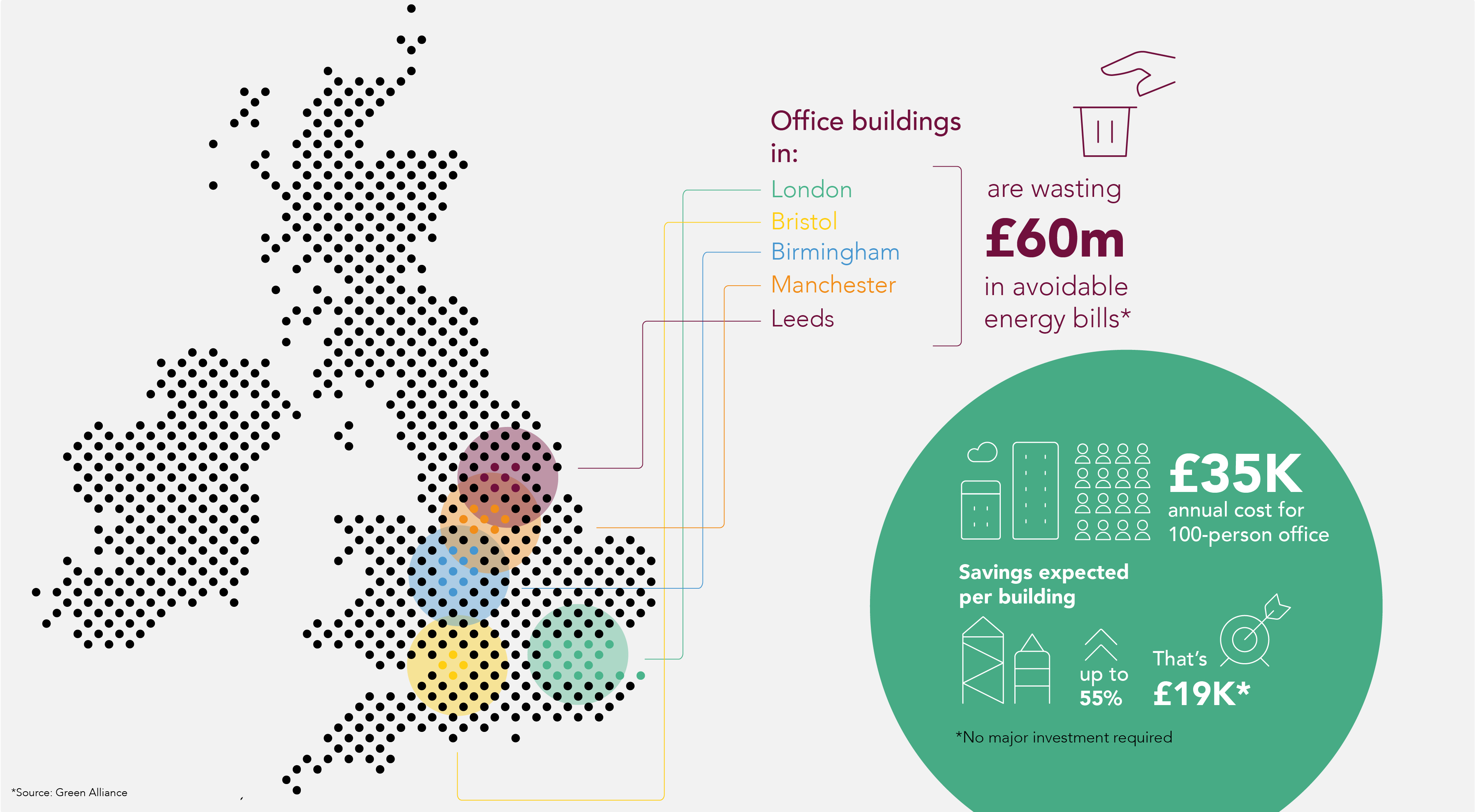
The UK's ambitious goal of reaching net zero carbon emissions by 2050 is going to take considerable collective effort. As a major contributor to the UK's carbon footprint, the built environment has an opportunity to make a substantial difference. Decisions made now will prove crucial.
Much then depends on the performance of our office premises. Analysis of decades of data by the UK's independent Committee on Climate Change shows how challenging it has been to cut carbon emissions associated with commercial buildings. But this means we have not yet seen the full potential of what the sector can do to improve energy efficiency.
To effect lasting transformation in the way buildings use energy requires an original approach. This is where we believe that behavioural change using gamification can help.
Need to cut commercial building energy use
It's estimated that, to fulfil net zero commitments, the UK's commercial real estate must cut its energy use by 60% by 2050. This poses a big challenge because, when it comes to building uses, offices are in the top three consumers of energy. According to the Green Alliance, some £60m a year is wasted by just a few thousand commercial properties across five of the UK's major cities: London, Manchester, Birmingham, Bristol and Leeds.
But energy efficiency is not just about the design and build stage: even properties with high sustainability ratings can waste energy if they are used inefficiently. So how should energy usage in existing buildings be addressed?
The instinctive reaction is often to start spending on big retrofits. But these can be time and cost intensive. More importantly, they ignore the fact that a large part of their success depends on elements outside building managers' control, such as how occupiers use the building.
'Even properties with high sustainability ratings can waste energy if they are used inefficiently'

Taking a behaviour-led approach
Change begins by focusing on mindsets and behaviours. In fact, nearly two-thirds of the emissions reductions required to achieve net zero targets will rely to some degree on behavioural change.
One key strategy in behavioural change is gamification, where game-design features are introduced into new contexts to enhance engagement, learning and motivation. Elements such as score boards comparing participants' performance, and awards, help to inspire a competitive environment. There is sufficient evidence that applying it to commercial real estate offers great benefits. The International Energy Agency (IEA), for instance, highlights the value of 'energy-saving competitions and games' with 'milestones and targets that trigger rewards'.
Behavioural change should be the first step in cultivating vital relationships among those that own, run and use commercial buildings. Rather than imposing green leases or strict sustainability rules on occupiers, all parties – landlords, building managers and users – should be motivated to work together towards common objectives in a fun, interactive way, instilling an energy-saving culture across workplaces.
Unsurprisingly, behaviour is one of the most difficult characteristics to change. Most people have deep-rooted or unconscious behaviours and habits, and don't fully understand how their everyday energy use causes waste or higher bills.
Months spent working remotely during COVID-19 lockdowns, though, have made many more people conscious and interested in limiting waste at home, and keen to do the same when returning to the office. A top-down approach with facilities managers issuing instructions can be easy to ignore, or seen as a chore. Successful change requires a grassroots effort with engagement from occupiers.
The key is to do this in a way that is interactive and stimulating, rather than burdensome. This is the main advantage of gamification. It shows that individual efforts – including more considered use of lighting, heating and appliances – do add up.
For example, the IEA finds that, for space heating alone, behavioural changes can enable some of the most significant reductions in carbon emissions by 2025 on a global scale.
Key principles of gamification
Gamification has been tried and tested as a means of changing behaviours across a range of sectors, from video gaming to energy use in individual homes and commercial offices. The key principles that make gamification work are as follows.
Make it easy to adopt
Fostering new habits often involves taking a first step, so the opportunity to do so should be easy and fun. Perhaps the most valuable part of gamified sustainability schemes is that they show how small steps translate into savings without complicated reporting. Once the experience is enjoyable and fulfilling, people will want to continue and build on what they've already achieved.
Initiatives that use what people have at hand already, namely their utility bills, have been highly successful. This is the approach that the CUBE Competition has adopted. CUBE is a year-long competition on energy reduction between commercial buildings, designed to inspire collective action towards net zero through simple behaviour changes and building reprogramming. In this innovative competition, monthly energy consumption is compared to historical energy use data, with rankings showing improvements against that baseline and prizes for top performers by sector and location. Having already delivered energy reductions of up to 55% in France, where it has run for more than six years, the competition is coming to the UK this year.
Provide continuous feedback and motivation
New year's resolutions often fall flat after the first couple of weeks because they lack two key qualities: regular feedback and motivation. Successful gamification schemes typically provide monthly rankings to help you benchmark against your peers and give you a target to achieve or beat for the month ahead. This regular feedback helps you keep your goals manageable and in mind, while showing how your actions are having an impact.
Be fair
A game that is thought to be unfair will put off potential competitors. In the case of buildings competing on energy, like must be compared with like, meaning that other building sizes or types are not automatically at a disadvantage. Similarly, to ensure everyone has a fair opportunity to develop and embed positive behaviours, any competition should be held over a sufficiently long timeframe to track a building's performance, e.g. one year.
Develop a community
It is not uncommon for people to question the impact of their individual actions in tackling climate change and other environmental crises. Will saying no to a plastic straw really save the turtles? However, when you see thousands of people working towards the same goal, it cultivates a sense of community and reassures participants that a meaningful impact can be made.
Switching off four lights around the workspace each night for a year could reduce a building's carbon footprint by the equivalent of flying from London to Paris ten times. Those might seem like decent savings already – but when you multiply them by the thousands of commercial buildings across the UK, you see how small actions can accumulate. One of the unspoken benefits of gamification, ironically, is that those you compete against are also making an impact.
Celebrate success
This collective achievement means the sector can celebrate success together. The sheer number of awards programmes across almost every profession is an indicator that people enjoy being recognised for their hard work. Beyond this, though, it is vital to showcase lessons, savings and insights into best practice. This will encourage other commercial asset classes, as well as peers and colleagues, to follow suit.
Mark Bruno is chief ambassador of CUBE and partner at Ampersand Partners
Related competencies include: Sustainability
